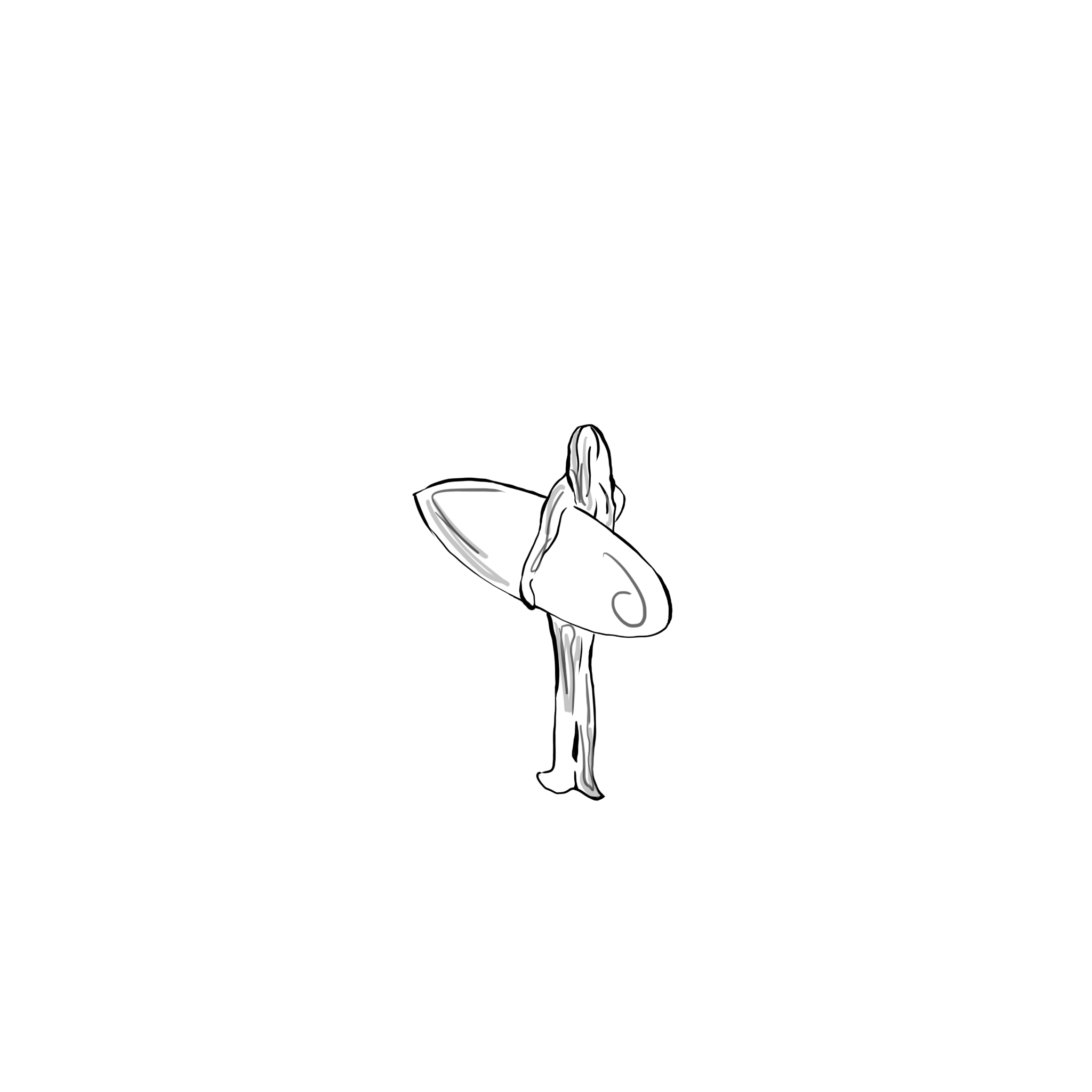berawa beach
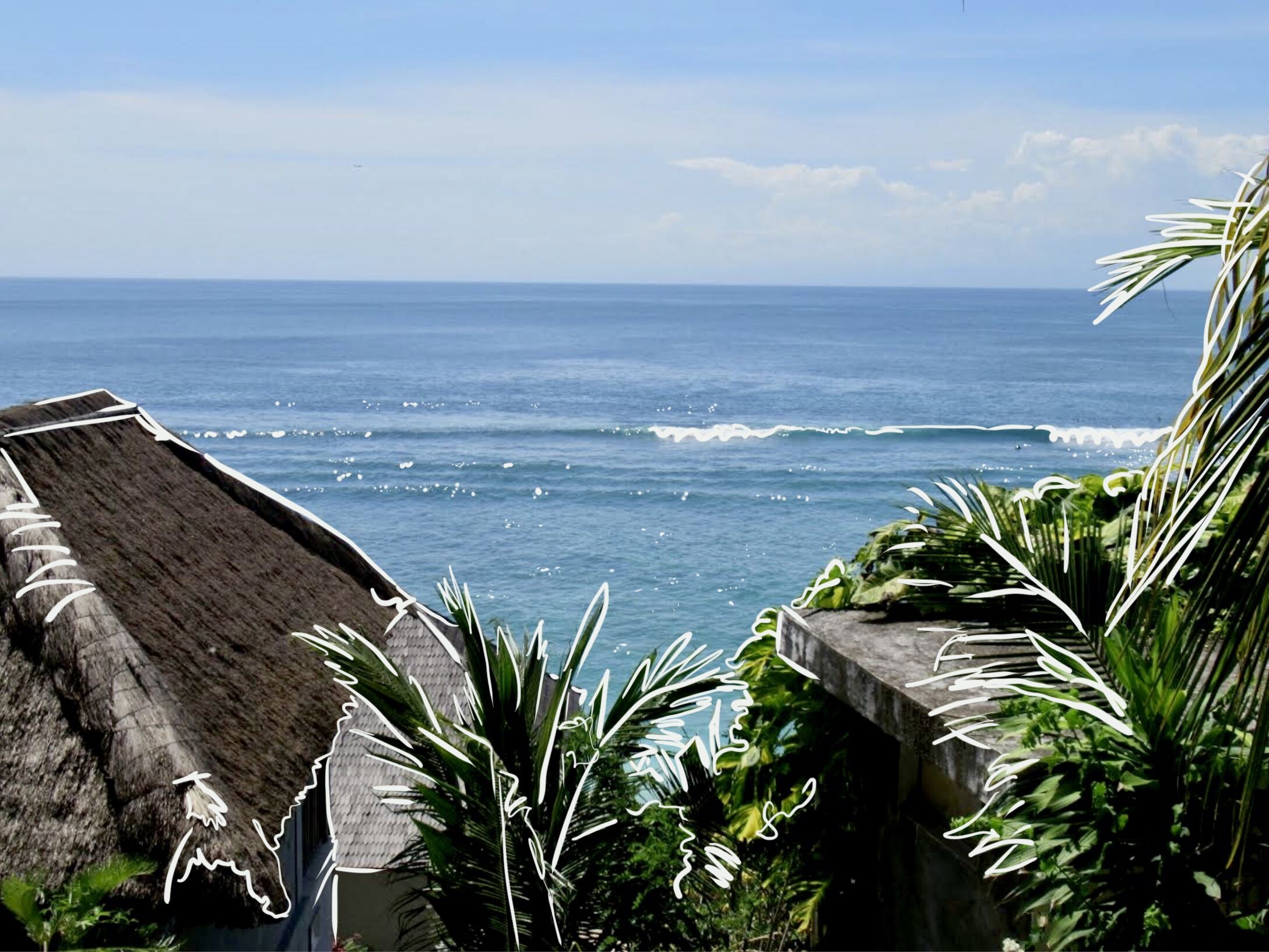
I sit on the dark, sparkly sand and dig my fingers into the damp grains. The beach which runs along the broad curve of the bay has many names: Berawa Beach, Canggu Beach, Nelayan Beach, Batu Bolong, etc. Each name traditionally refers to an exact section of the long stretch of sand, but they are generally used interchangeably. Bali itself is a place of many names — drive for five minutes in the South-West peninsula of the island and you’ll blow through at least 20 place-names, whether it’s markets, villages, towns, counties, or cities. I find it peculiarly charming, as if each tiny parcel of land has enough character to warrant its own special label. Or as if this place has so infested the souls of its people that they over-bestow the flattering Balinese names.
The first thing I’ve always done in Canggu, and really anywhere that allows it, is march to the beach. Finding the sun hovering over the horizon helps me get my bearings, it’s somehow strangely reassuring to know which side of a landmass I’m on. Locals and expats park their scooters along the winding inner road that traces a path parallel to Berawa Beach, slapping a blue-toned 2000 rupiah bill in the hand of a parking overseer or avoiding the fee by dapping up a friendly one. They freeze momentarily, staring out over the sand to where the frothy white water marches towards the beach before toppling over into the smattering of surfers already in the waves. Sometimes, glancing away from the ocean towards the road, I will see an unwavering row of these kinds of sentinel statues: surfers caught in a rare moment of inactivity while they study the break before lifting their boards from the hooks on the side of their bike and heading for the waves.
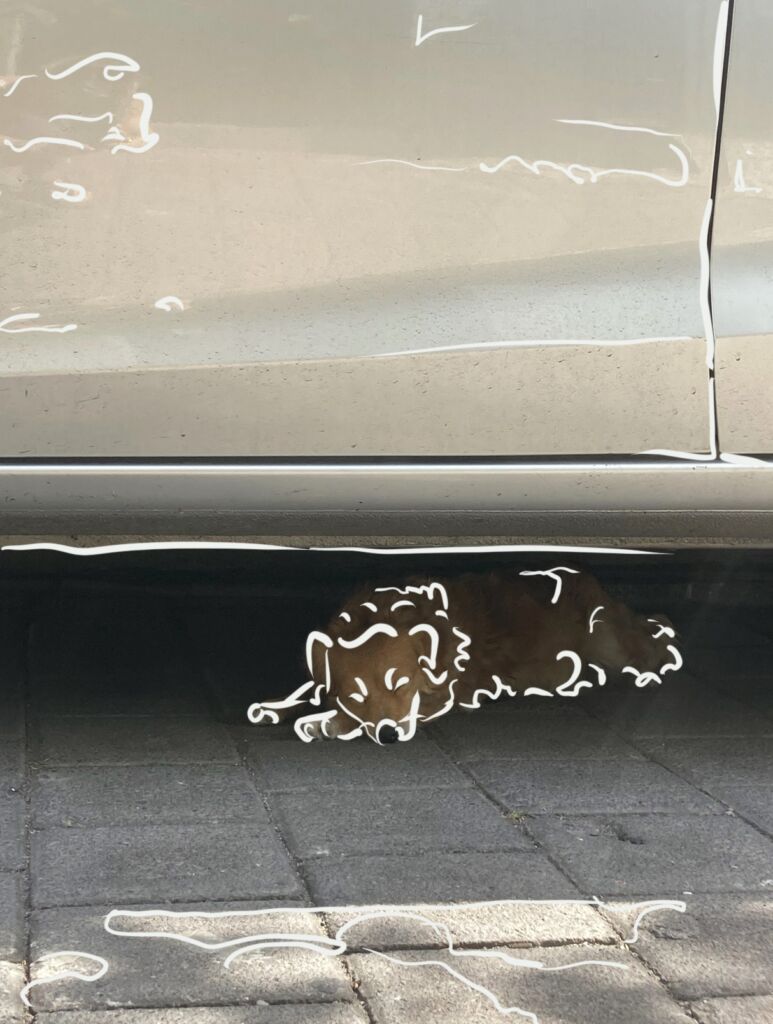 Kids, expats and locals mostly, tumble in the sea foam at the edge of the ocean, teasing the wavelets which make it past the surfers and diving headfirst into the sandy shallows. They troop back up the beach towards chatting parents, sand mixed with tears and snot, after an incoherent brawl with two mangy puppies. The puppies yelp and bounce down the beach. I peel my legs off the pleather seat of our scooter and dodge the small animals around my ankles before rushing across the road to FIVE, my favorite of the countless well-used surf shacks on Berawa Beach. Almost exactly three years ago my mom had dragged my sisters and I to this same shack and handed us into the gentle hands of Komang, the smiliest surf guide in Canggu. He stands a head taller than me with a broad face, frame, and hands. He moves slowly and elegantly, treating everything with an incongruous delicacy. Komang scolded us onto waves for a week straight (after which my mom insisted we surf for free, see: alone), his wide smile unbothered by our protests or the tumultuous weather. But three years later that smile has faded. My Bahasa too poor to ask him anything substantial, we reunite with a quick hug and he treats me to a glimpse of a smirk. Noticing the increasingly battered boards under the shelter and eavesdropping on the conversations of the half-dozen other surf guides, I gather that COVID had hit FIVE pretty hard.
Kids, expats and locals mostly, tumble in the sea foam at the edge of the ocean, teasing the wavelets which make it past the surfers and diving headfirst into the sandy shallows. They troop back up the beach towards chatting parents, sand mixed with tears and snot, after an incoherent brawl with two mangy puppies. The puppies yelp and bounce down the beach. I peel my legs off the pleather seat of our scooter and dodge the small animals around my ankles before rushing across the road to FIVE, my favorite of the countless well-used surf shacks on Berawa Beach. Almost exactly three years ago my mom had dragged my sisters and I to this same shack and handed us into the gentle hands of Komang, the smiliest surf guide in Canggu. He stands a head taller than me with a broad face, frame, and hands. He moves slowly and elegantly, treating everything with an incongruous delicacy. Komang scolded us onto waves for a week straight (after which my mom insisted we surf for free, see: alone), his wide smile unbothered by our protests or the tumultuous weather. But three years later that smile has faded. My Bahasa too poor to ask him anything substantial, we reunite with a quick hug and he treats me to a glimpse of a smirk. Noticing the increasingly battered boards under the shelter and eavesdropping on the conversations of the half-dozen other surf guides, I gather that COVID had hit FIVE pretty hard.
FIVE doesn’t show up on Google Maps and has no website or phone number. It depends instead on the robust surfer grapevine and the surf shack’s gaggle of extremely extroverted surf guides, people people if I’ve ever seen one. I’m no econ major, but I hazard a guess that this business model was the reason the surf shack survived the pandemic at all; my own experience is racked with surfers too stubborn and ocean-addicted to heed world health guidelines and abandon their favorite breaks. Shuttered shops deteriorating next to shiny new ones along the Canggu roads tell the sad story common to tourist economies these days.
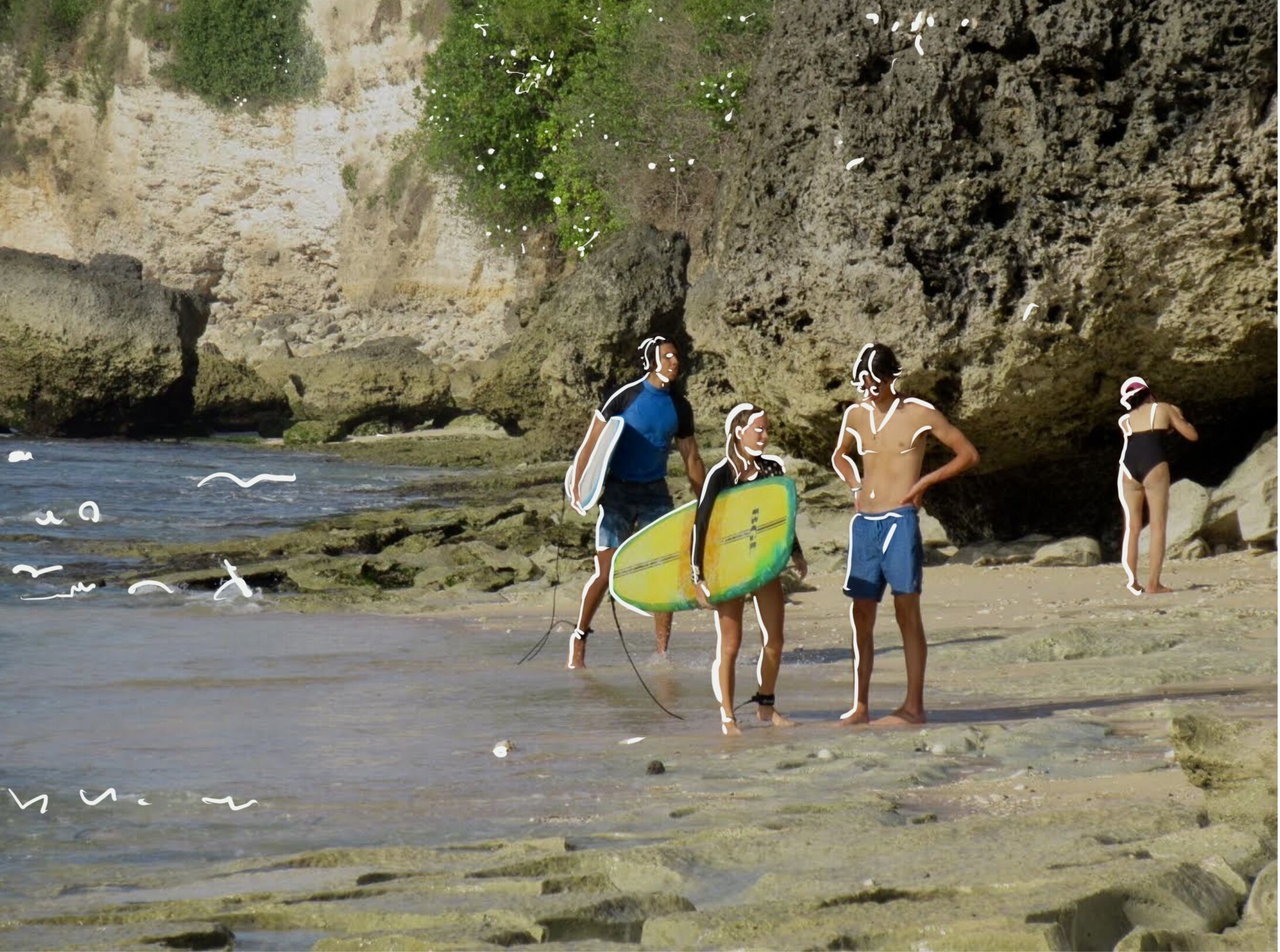
Beginners struggle through the waves on thick foam boards while their surf guides glide next to them. I catch a few phrases from the beach, “Go right! Go right!”, “Stand up! Stand up!” A couple walks past between us and the ocean; the woman is chortling and the man turns smiling to beckon an ancient dog onward. In a town with no parks or plazas, no sidewalks or squares, the beach functions as all four and more. It draws residents looking to bump into friends, dogs needing a good run, couples just chatting outdoors, and tourists soaking up the sun. The beach is a free and open place where almost anything goes and almost everything is welcome.
Canggu, like most, if not all, Balinese towns, is remarkably unfriendly to walkers. Built to accommodate the scooters ridden by its inhabitants, Canggu features exactly one sidewalk and all other roads meet the buildings at their doorsteps. With the scooters in mind, Balinese buildings also typically add a small ramp into their driveway, courtyard or parking lot, meaning that any walkers attempting to navigate the perilous streets must conquer surprisingly steep concrete slopes. On my own scooter, I’m absurdly grateful for scooter-minded infrastructure, but resent it immediately when it becomes necessary to fire up the vehicle for a 30-second trip around the corner. And so, over the years Berawa Beach has become the only practical way to stroll from one end of town to the other.
My personal relationship with this place is harder to explain. Sometime during my first or second grade, some close family friends moved from Italy to distant Bali in what seemed to my young mind to be a very abrupt fashion. I was intrigued. Upon their return they showed us an intricate home movie featuring my friends as spies and FBI agents tracking an expensive wedge of Parmigiano Cheese through hypnotizing scenes of Balinese beaches, Bangkok food courts, and Italian alleyways.
Years later, in the first weeks of my senior year of high school, I first set foot on the island. My family had been sailing for endless months through the Indonesian sea, and everywhere we heard of Bali. We were told that was where we would find a big airport, that was where there were bars, that was where we could do our scuba certification, that was where most people seemed to go when they went to Indonesia. But our arrival was anticlimactic; all boats arriving in Bali are moored in a large, murky industrial harbor lined with shipyards, cargo lots, and seamen’s amenities (pubs, guesthouses, dumpsters). I remember early mornings spent on the top deck watching fishermen wade into the mud and cast their lines out among the silent boats. Following rumors of beginner-friendly surfing, my family and I soon found ourselves tucked into a small Canggu villa. I fell into a dreamlike routine. Dawn meant surfing with Komang, breakfast meant schoolwork and smoothie bowls at a co-working space built of bamboo and snakevine. My sisters and I basked in the simple luxuries of the island: sun, fruit, smiles, and waves.
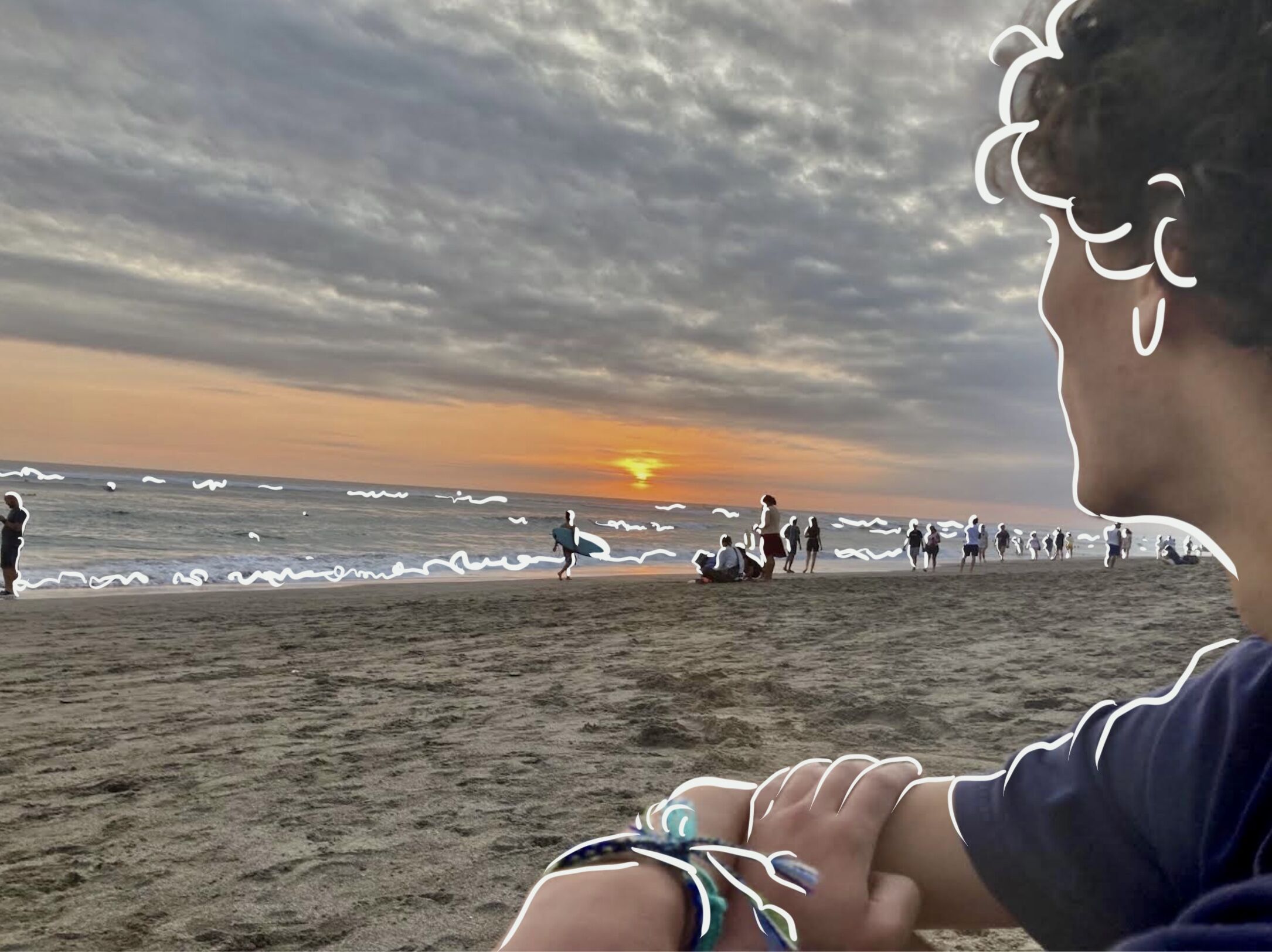
I formed a thrilling friendship with a girl a year older than me who I’d met at an opulent Italian dinner hosted by a Milanese couple. She brought me to the beach one night, except this time I was greeted by a picnic table of highschool faces and several handles of cheap liquor. I met French, German, Chinese, Balinese, Thai, and Indian kids who had been brought to the island for the wildest reasons. We sipped drinks at the table and small groups slunk down the beach to say and do things that only felt right where the dark ocean met the sand. I wrapped bare arms around a new friend and flew down the slim night roads on a white motorino. I watched the rice patties blur past me, and the sky became one wide, glimmering, milky-way.
 Returning with my friends, after two years of land-locked life at the University of Chicago, is dizzying and bittersweet. On my second morning back I eat a late breakfast at a roadside cafe near our villa. A white motorino pulls off the road next to our table, and a wave of old emotion washes over me as my friend embraces me. She drifts into my group of college friends like a sea star returned by the current, and for the morning, my two stories merge into one. When she departs with a quick peck on the cheek,I’m doomed to search for her face in the crowds on Berawa beach each day.
Returning with my friends, after two years of land-locked life at the University of Chicago, is dizzying and bittersweet. On my second morning back I eat a late breakfast at a roadside cafe near our villa. A white motorino pulls off the road next to our table, and a wave of old emotion washes over me as my friend embraces me. She drifts into my group of college friends like a sea star returned by the current, and for the morning, my two stories merge into one. When she departs with a quick peck on the cheek,I’m doomed to search for her face in the crowds on Berawa beach each day.
Sunset glints between the clouds and night looms behind me, threatening to end my last day on the beach. My boyfriend and I discuss the dichotomy of places people and people people. He identifies himself as the latter. I still struggle to find the difference, places and people tangle up in my brain like licorice laces. He nudges me, “Ben said that maybe I don’t get so attached to places because I grew up in the midwest, everything kind of looks like everywhere else there.” I laugh but am not sure it’s that simple.
